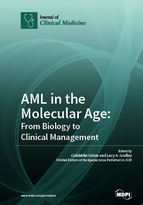AML in the Molecular Age: From Biology to Clinical Management
A special issue of Journal of Clinical Medicine (ISSN 2077-0383). This special issue belongs to the section "Hematology".
Deadline for manuscript submissions: closed (20 September 2014) | Viewed by 109420
Special Issue Editors
Interests: AML; elderly AML; alloHCT; infectious complications; systemic mastocytosis
Special Issue Information
Dear Colleagues,
We appreciate your willingness to contribute an article to the upcoming Special Issue of the Journal of Clinical Medicine, which will focus on “AML in the Molecular Age: From Biology to Clinical Management”. In this Special Issue, we aim to discuss important scientific and clinical ongoing activities in AML. Scientific subjects will include articles concerning the epigenetic mechanisms of disease/therapy as well as the role of the immune system in AML. Very interesting and uncommon subjects will include discussions of extramedullary disease and evaluations of the central nervous system by various imaging techniques. Experts will describe the role of hypomethylating agents in the management of AML and currently emerging and promising investigational therapies. Clinical success relies greatly on supportive therapy, and we will discuss supportive therapy, including infection prophylaxis. Allogeneic hematopoietic stem cell transplantation remains the most effective measure for curing aggressive AML, and a variety of topics will be considered: donor selection, age of recipient, which has been increasing seemingly without limit; therefore, recipient/donor assessments are more important than ever in the aging population. Alternative donor use (e.g., cord blood and haploidentical individuals) has been increasing dramatically; when and who should be considered, what is being investigated? With significant changes occurring with respect to both donors and recipients, the pros and cons of using of anti-thymocyte globulin use in conditioning regimens will be also described.
We have included an overall outline here for your review and ask that you forward to us your final title by 20 August, 2014. We remind you that there will be NO page charges or extra charges for color figures. Articles will be due to us on September 20, 2014
Once again, we look forward to your participation.
With best regards,
Dr. Celalettin Ustun
Dr. Lucy A. Godley
Guest Editors
Manuscript Submission Information
Manuscripts should be submitted online at www.mdpi.com by registering and logging in to this website. Once you are registered, click here to go to the submission form. Manuscripts can be submitted until the deadline. All submissions that pass pre-check are peer-reviewed. Accepted papers will be published continuously in the journal (as soon as accepted) and will be listed together on the special issue website. Research articles, review articles as well as short communications are invited. For planned papers, a title and short abstract (about 100 words) can be sent to the Editorial Office for announcement on this website.
Submitted manuscripts should not have been published previously, nor be under consideration for publication elsewhere (except conference proceedings papers). All manuscripts are thoroughly refereed through a single-blind peer-review process. A guide for authors and other relevant information for submission of manuscripts is available on the Instructions for Authors page. Journal of Clinical Medicine is an international peer-reviewed open access semimonthly journal published by MDPI.
Please visit the Instructions for Authors page before submitting a manuscript. The Article Processing Charge (APC) for publication in this open access journal is 2600 CHF (Swiss Francs). Submitted papers should be well formatted and use good English. Authors may use MDPI's English editing service prior to publication or during author revisions.
Keywords
- hypomethylating agents
- novel therapy
- epigenetics
- allogeneic hematopoietic cell transplantation
- T cell depletion
- umbilical cord blood transplantation







